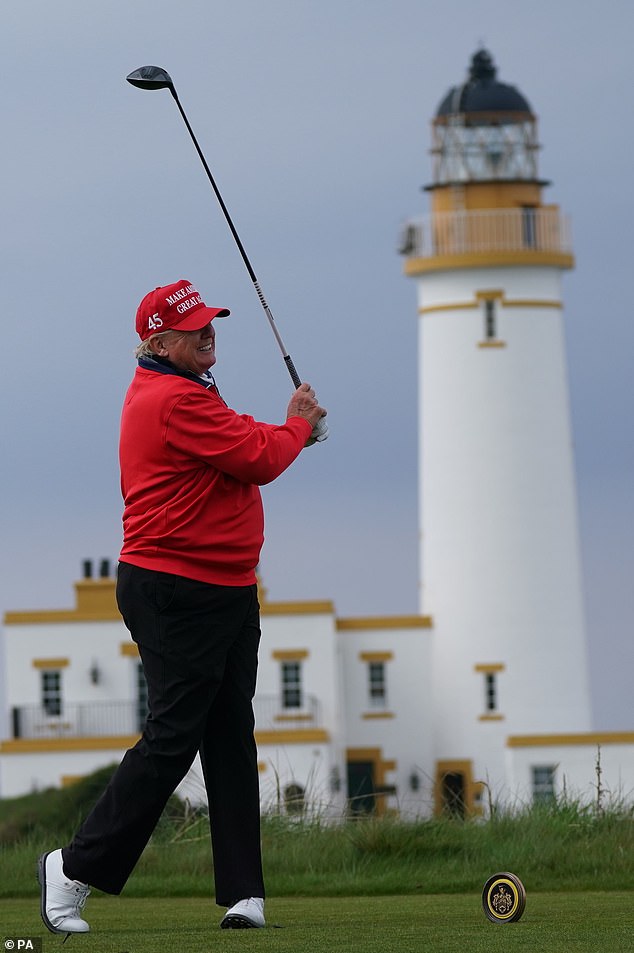The Return of Donald Trump to Turnberry: What It Means for The Open Championship
After landing at Prestwick Airport last night, former President Donald Trump disembarked from Air Force One and headed straight to his luxurious resort at Turnberry, Ayrshire. Amid significant political and social turbulence, Trump’s visit brings a renewed focus on the future of golf in Scotland, particularly regarding his golf course at Turnberry and its potential to once again host The Open Championship.
The Open Championship Aspiration
During his visit, Trump made it clear that he has aspirations for Turnberry to host the prestigious Open Championship once again. The prospect of bringing this world-renowned golfing event back to Ayrshire has garnered serious attention in recent months. The Ailsa Course, known for its stunning views and rich golfing history, last hosted The Open in 2009, a time when golf legends battled for the coveted Claret Jug.
The Mixed Bag of Reception
Trump’s arrival comes at a time of mixed public sentiment. While he has his share of supporters, protests and petitions against his involvement in Scottish golf have emerged. The discussion surrounding Turnberry’s potential return to The Open rota has reignited debates around the former President’s controversial image and its implications for the sport.
The R&A’s Ongoing Negotiations
Mark Darbon, the new chief executive of the R&A, has acknowledged ongoing talks with the Trump family regarding the status of Turnberry. He emphasized the course’s virtues: “We love the golf course but we have some big logistical issues there.” The dialogue surrounding Turnberry is crucial, not just for its historical significance, but for its potential role in the future of Scottish golf.
The Historical Significance of Turnberry
Turnberry has a storied history with The Open Championship, having hosted the tournament four times. The most notable moment came in 1977 with the iconic "Duel in the Sun" between Jack Nicklaus and Tom Watson. Subsequent championships in 1986 and 1994 solidified its reputation as one of the premier venues in the world. Yet, it has since fallen out of favor following Trump’s acquisition of the property in 2014, amid rising political tensions and changing institutional priorities.
Logistical Challenges at Turnberry
One of the recurring criticisms about Turnberry is its logistical shortcomings compared to other Open venues. Prospective attendees from Ayr or Glasgow face limited access routes, with just two main roads leading to the resort. Although recent improvements to local infrastructure have made accessing the site easier, the general consensus is that Turnberry remains less accessible than courses like St Andrews or Royal Portrush.
The R&A’s Cautious Approach
Upon experiencing decreased attendance at previous tournaments, the R&A has adopted a cautious approach towards Turnberry. Martin Slumbers, Darbon’s predecessor, indicated that any discussions about hosting events at Turnberry were contingent upon ensuring that conversations around the venue remained focused purely on golf without political distractions.
Trump’s Investment in Turnberry
Since acquiring Turnberry, Trump has pledged to invest an estimated £200 million in renovations and facility upgrades. Changes have been made to both the course and the resort’s accommodation, further enhancing its reputation as a golfing destination. The Ailsa Course has undergone significant alterations, particularly from holes 4 through 11. The establishment of new hospitality facilities at the iconic lighthouse has also been well received, particularly among guests looking for a luxurious experience.
The Cost of Golf at Turnberry
However, for the average golfer, experiencing Turnberry is not without financial implications. Green fees are notably high, currently priced at £1,000 for peak times—making it one of the most expensive rounds in Europe. For hotel guests, discounted rates apply, but overall, playing at Turnberry remains a luxury experience that many find unatainable.
Financial Implications of Hosting The Open
As the R&A considers Turnberry’s viability as a future venue for The Open, financial aspects loom large. With record-breaking attendance figures at recent tournaments—including upwards of 250,000 fans—there are concerns that Turnberry’s relatively remote location could lead to lower attendance and, consequently, decreased revenue. The R&A must weigh these logistical and financial risks carefully before reintroducing Turnberry to the Championship’s rota.
Future Prospects for The Open Championship
Looking ahead, the upcoming Open Championship schedules are set. Future events are already planned for venues such as Royal Birkdale in 2026 and St Andrews in 2027. The possibility of adding Portmarnock in Ireland to the rota for 2028 could push Turnberry’s potential return even further into the future.
Conclusion: Awaiting the Claret Jug
While Trump’s visit to Turnberry reignites hope for its revival in hosting The Open, it’s clear that there are numerous hurdles to overcome. Ongoing discussions with the R&A reflect a recognition of Turnberry’s allure among golfers, yet substantial improvements in logistics and infrastructure will be necessary before it can once again be a viable host. As Trump navigates his Scottish tour, fans will be waiting eagerly for more news about Turnberry’s future role in one of golf’s most prestigious events.
Continuing developments will certainly keep both golfing enthusiasts and political watchers on standby. The relationship between Turnberry, the R&A, and Trump remains dynamic, reflecting not only the complexities of sports management but also the intricate dance of politics and public sentiment that surrounds it.


